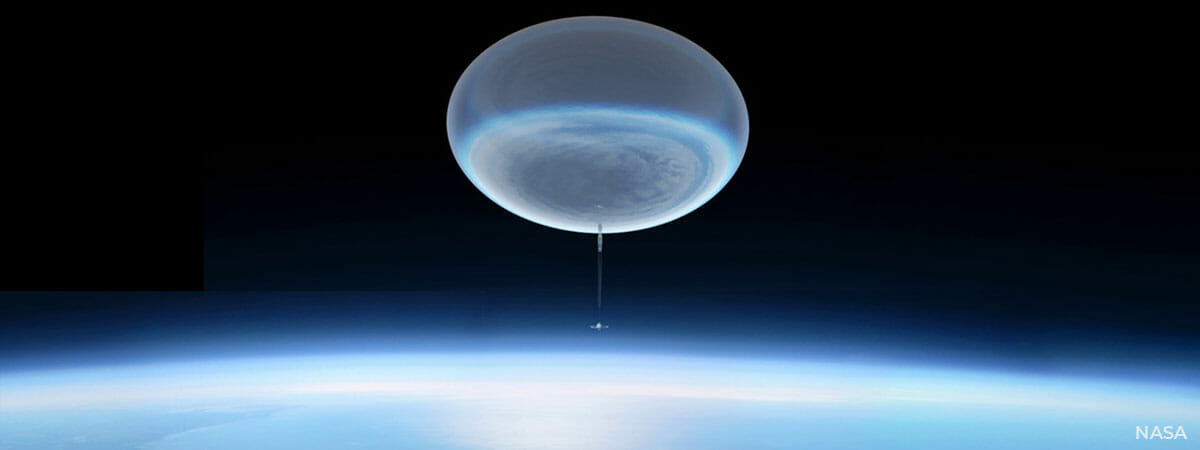For a long time they have been unknown or, at least, unnoticed by the public. However, the case of the balloon brought down by the US government recently and similar incidents in Canada and other countries have raised many questions about these aircraft.
Balloons have been used since the eighteenth century for both civil and military purposes and even today, when technology offers many alternatives, they are still preferred for some uses.
First, we should get a clear idea of the type of balloons we are talking about. They are not the recreational hot-air balloons that we often see floating above the countryside, but more specialised balloons, which operate at considerable heights. You can find detailed information about them on NASA websites, such as Scientific Balloons or the Columbia Scientific Balloon Facility
In these pages balloons for scientific use are divided into three main categories, according to the duration of the flight: conventional balloons, Long Duration Ballooning (LDB) and Ultra Long Duration Ballooning (ULDB). The first group refers to commercial hot-air balloons, recreational balloons and balloons used for transport, which are the ones we are most familiar with. However, for the case we are considering, the most interesting categories are LDB and ULDB.
LDB means that the duration of the flight is about 3 weeks. During that time these balloons can cross continents or fly right round the world. Electronic systems based on artificial satellites are used to control these balloons and capture data. For the ULDB category, balloons must be able to fly up to one hundred days. They are designed in the shape of a pumpkin and can withstand significant pressure changes.
These special balloons, generally intended for scientific use, are also known as stratospheric balloons and can carry payloads at altitudes of up to 40 kilometres, where the atmosphere is very thin and the effects of gravity are lessened. At this altitude scientists can carry out experiments that are impossible at ground level but would be very costly to conduct in space in similar conditions. To give a clearer idea of what this height means, we can say that it is almost a third of the height of Low Earth Orbit (LEO) artificial satellites. This orbit starts at 150 km from the Earth’s surface and reaches 2000 km. Most observation satellites are in that range, as are the International Space Station and the Hubble Space Telescope.
NASA and other space agencies have used scientific balloons for many years to carry out a wide variety of research missions. These include studying the Earth’s atmosphere and climate, exploring planets and distant galaxies, telescopes being fitted on these balloons to take advantage of the fact that at that height the atmosphere is cleaner and less dense (as happens, to a certain extent, with observatories on mountains). Indeed, scientific balloons are an economic and flexible alternative to conventional satellites, as they can carry much larger, heavier and more complex payloads.
Apart from the flight’s duration, balloons are also classified according to the different types of scientific experiments for which they are used. Again according to NASA, we would have the following types:
- High-altitude balloons: These are the most common scientific balloons used by meteorology agencies in different countries to study the Earth’s atmosphere, climate, and solar physics. These balloons can carry payloads of up to four tons at altitudes of more than 36 kilometres, allowing scientists to study the Earth’s atmosphere and meteorology from a unique perspective. The Chinese balloon that was shot down could be this type, according to some sources.
- Polar balloons: These are used to study the atmosphere and space around the poles. They are launched at the North Pole or the South Pole and fly around the pole for several days, allowing scientists to study the Northern Lights and Southern Lights, as well as the climate in polar regions, which has a major impact on the climate of the whole planet.
- Long-range balloons: Designed to study remote regions, such as the Pacific Ocean or the Arctic. These balloons can fly for several days and carry equipment to measure water temperature, salinity and turbulence, making it possible to conduct oceanographic and meteorological studies in regions where it is difficult to maintain a weather station.
- Telescope balloons: These are used to carry optical or electronic astronomical observation devices and, as mentioned above, can reach heights of up to 40 kilometres. In this location, scientists can carry out astronomical and astrophysical studies from an even better perspective than that provided by observatories located in isolated mountain areas, by avoiding the effects of the lower atmosphere and light pollution. In addition to conventional optical telescopes, they can carry other payloads designed to measure cosmic radiation, or study the composition of the universe and the formation of stars and galaxies.
Scientific balloons are not new, but have been used for decades as an important tool for scientific research ranging from studying the atmosphere and climate of the Earth to exploring planets and distant galaxies. Given their payload capacity and the low cost of launching them, they can be easily adapted for different types of scientific experiment.
Among the laboratories that specialise in working with this type of balloon, NASA has the Columbia Scientific Balloon Facility (CSBF), a scientific research centre located in New Mexico, dedicated to the design, construction, launch and operation of scientific balloons for research into the atmosphere and space.
The CSBF is an agency that forms part of NASA and is managed by its Goddard Space Flight Center. The facility has a staff with multi-disciplinary backgrounds, including engineers, technicians and scientists, and operates the world’s largest and most advanced scientific balloon fleet.
The scientific balloons developed and operated by the CSBF are among the largest that have been officially documented. They have payload capacities ranging from a few hundred kilograms to more than four tonnes. These balloons take off from a specially designed launching pad, which ensures safe operation, as well as easy payload recovery after flights.
An unconventional example of the uses of these scientific balloons and, above all, their versatility is NASA’s BITSE (Balloon Investigation of Temperature and Speed of Electrons in the corona) Solar Scope project, which aims to study the solar corona.
The BITSE Solar Scope project uses a high altitude balloon to position a specialised telescope about 36 kilometres above the Earth. The telescope is designed to study the solar corona, the outermost and least understood layer of the Sun’s atmosphere, where temperatures are extremely high and particles move very fast. It is able to measure the temperature and velocity of electrons in the solar corona using radio spectroscopy. Data can thus be obtained on how energy and heat are transferred through the corona and how solar storms can affect the Earth.
Since the Montgolfier brothers flew their first balloon publicly in Paris in 1783, these aircraft have been used for many purposes, both civil and military. They have been a vehicle for exploration, observation, the transport of passengers and goods, sporting competitions, espionage and even bombing in times of war. Although the appearance of planes pushed them into the background, they have continued to be used for a wide range of purposes to this day. Some of the biggest competitions in the twentieth century and the current one have involved hot air balloons, including the Coupe Aéronautique Gordon-Bennett, in which Félix Gómez-Guillamón took part, which we have already talked about in this blog (read here).
Returning to the case of the Chinese balloon that was shot down recently, there is a feature common to all balloons since the day when the Montgolfier brothers launched theirs: regardless of their use, balloons fly where the wind takes them (more or less). Consequently, irrespective of the mission for which it was intended, lack of control over a balloon’s route can cause incidents such as the one mentioned above.



